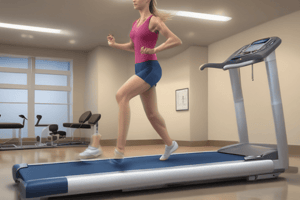Podcast
Questions and Answers
A patient exhibits a hip hiking gait pattern. What is the primary movement observed in the pelvis during this gait?
A patient exhibits a hip hiking gait pattern. What is the primary movement observed in the pelvis during this gait?
Excessive knee extension, or genu recurvatum, during gait is commonly caused by which of the following muscle imbalances?
Excessive knee extension, or genu recurvatum, during gait is commonly caused by which of the following muscle imbalances?
A patient presents with a bent knee gait pattern. Which of the following is NOT a common cause of this gait deviation?
A patient presents with a bent knee gait pattern. Which of the following is NOT a common cause of this gait deviation?
During the stance phase of gait, a patient exhibits a ‘foot slap’. Which of these options is the LEAST likely cause of this clinical presentation?
During the stance phase of gait, a patient exhibits a ‘foot slap’. Which of these options is the LEAST likely cause of this clinical presentation?
Signup and view all the answers
A patient is observed with an antalgic gait. Which of the following best describes the characteristics of this type of gait pattern?
A patient is observed with an antalgic gait. Which of the following best describes the characteristics of this type of gait pattern?
Signup and view all the answers
During the initial contact phase of gait, which muscle group is primarily active?
During the initial contact phase of gait, which muscle group is primarily active?
Signup and view all the answers
What is the approximate knee angle during the loading response phase of gait?
What is the approximate knee angle during the loading response phase of gait?
Signup and view all the answers
Which muscle group is primarily active during the midstance phase to stabilize the hip?
Which muscle group is primarily active during the midstance phase to stabilize the hip?
Signup and view all the answers
What is the typical ankle position during the terminal stance phase?
What is the typical ankle position during the terminal stance phase?
Signup and view all the answers
Which muscle is responsible for the rapid knee flexion during the pre-swing phase?
Which muscle is responsible for the rapid knee flexion during the pre-swing phase?
Signup and view all the answers
What is the hip angle during the initial contact phase of gait?
What is the hip angle during the initial contact phase of gait?
Signup and view all the answers
What primary action occurs at the ankle during the loading response?
What primary action occurs at the ankle during the loading response?
Signup and view all the answers
What best describes the muscle activity of the knee at terminal stance?
What best describes the muscle activity of the knee at terminal stance?
Signup and view all the answers
During the mid-swing phase of gait, what is the primary role of the knee flexors?
During the mid-swing phase of gait, what is the primary role of the knee flexors?
Signup and view all the answers
Which muscle group is primarily responsible for decelerating the unsupported limb during the late swing phase of gait?
Which muscle group is primarily responsible for decelerating the unsupported limb during the late swing phase of gait?
Signup and view all the answers
What is the typical range of motion for hip flexion during normal gait?
What is the typical range of motion for hip flexion during normal gait?
Signup and view all the answers
If a patient exhibits excessive lateral trunk flexion and weight shifting over the stance leg, what gait pattern are they likely demonstrating?
If a patient exhibits excessive lateral trunk flexion and weight shifting over the stance leg, what gait pattern are they likely demonstrating?
Signup and view all the answers
During which phase of gait is the tibialis anterior most active?
During which phase of gait is the tibialis anterior most active?
Signup and view all the answers
What is the primary function of the gastrocnemius/soleus group during the late stance phase of gait?
What is the primary function of the gastrocnemius/soleus group during the late stance phase of gait?
Signup and view all the answers
During terminal swing, the quadriceps are primarily responsible for what action at the knee?
During terminal swing, the quadriceps are primarily responsible for what action at the knee?
Signup and view all the answers
Which of the following is a potential cause of a circumduction gait pattern?
Which of the following is a potential cause of a circumduction gait pattern?
Signup and view all the answers
Study Notes
Screening Gait
- Gait assessment is an important part of a physical exam
- Gait assessment should be performed when returning a patient to a room after other assessments to avoid unnecessary repetition
- Gait assessment should be ordered after subjective & constitutional symptoms, cardio screen & neuro screen, and clinical movement exam
Where Does Gait Fit In?
- Subjective symptoms and constitutional symptoms should be assessed first, then cardio and neuro screens, then the clinical movement exam, followed by palpation, range of motion, and manual muscle testing, and finally special testing
- Gait falls between cardio & neuro screens and the clinical movement exam in the order of examination
What's Normal?
- Defining "normal" gait is important, as it is a baseline for assessing potential abnormalities
- Normal gait should be characterized with specific ranges of motion and muscle activity, and these motions and muscle activity must be in the specific order
Normal Gait
- Gait cycle is divided into stance phase (60%) and swing phase (40%)
- Stance phase contains distinct sub-phases: heel strike, loading response, midstance, terminal stance, preswing
- Swing phase contains distinct sub-phases: initial swing, mid swing, terminal swing
- Specific muscle activity and angles of hip, knee, and ankles are associated with each sub-phase
Initial Contact
- The foot contacts the ground
- Hip displays 20° flexion
- Knee shows 5° flexion
- Ankle shows 0° angle
- Muscle activity associated with initial contact includes extensors, quadriceps, and pre-tibials
Loading Response
- Weight is rapidly transferred to the outstretched limb
- Hip displays 20° flexion
- Knee shows 15° flexion
- Ankle displays 5° plantar flexion
- Key muscles involved include extensors, abductors, quadriceps, and pre-tibials
Midstance
- Body progresses over a single stable limb
- Hip shows 0° angle
- Knee shows 5° flexion (observationally neutral)
- Ankle displays 5° dorsiflexion
- Abductors, quadriceps, and calf muscles are associated
Terminal Stance
- Progression continues on the stance leg
- Body moves forward and weight is transferred to the forefoot
- Hip shows 20° apparent hyperextension
- Knee is fully extended (5° flexion)
- Ankle displays 10° dorsiflexion
- No muscle is listed as being dominant for this phase
Pre-Swing
- Forefoot remains on the ground, while the weight is shifted
- Knee quickly flexes
- Hip displays neutral extension
- Knee shows 40° flexion
- Ankle shows 15° plantar flexion
- The adductors, popliteus, rectus femoris, and plantar flexors are involved in this phase
Initial Swing
- Thigh advances
- Knee continues to flex
- Foot clears the ground
- Hip displays 15° flexion
- Knee shows 60° flexion
- Ankle shows 5° plantar flexion
- Flexors and pre-tibials are involved in this initial swing
Mid Swing
- Thigh continues forward
- Knee starts extending
- Foot clearance is maintained
- Hip displays 25° flexion
- Knee shows 60° to 25° flexion
- Ankle displays 0° angle
- Flexors, and eccentric hamstring activity are involved here
Terminal Swing
- Knee extends
- Limb prepares to make contact
- Hip shows 20° flexion
- Knee displays 5° flexion to neutral
- Ankle displays 0° angle
- The hamstrings, quadriceps, and pre-tibials are involved here
Gait Abnormalities
- Trendelenburg gait: gluteus medius weakness, lateral trunk flexion, weight shifts to the stance leg
- Circumduction gait: a circular motion of the leg during swing, for compensating for insufficient hip or knee flexion or ankle dorsiflexion
- Hip Hiking gait: pelvis is lifted on the swinging leg
- Excessive Knee Extension (genu recurvatum)
- Bent Knee Gait: knee flexion contracture or weak quadriceps or hip flexion contracture
- Inadequete Ankle Dorsiflexion (Toe Drag): toe drag during swing, weakness of dorsiflexors, & spasticity of plantar flexors
- Antalgic gait: Decreased step length to avoid weight bearing on the involved side (usually due to pain)
- Ataxic gait: characterized by staggering and unsteadiness and wide support base. Movements exaggerated.
Gait Observations
- Patient presents with antalgic gait and increased stance time on the right due to left knee pain. Gait improved with cane use on right.
Studying That Suits You
Use AI to generate personalized quizzes and flashcards to suit your learning preferences.
Related Documents
Description
This quiz covers the essentials of gait assessment as part of a physical examination. It discusses the appropriate order of assessments leading up to the gait evaluation and the criteria for defining normal gait. Understanding these concepts is crucial for identifying abnormalities in patient mobility.





